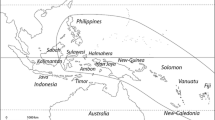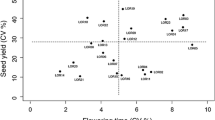Abstract
We report here that small but numerous foliar glands are present near the base of the abaxial leaf blades of hop (Humulus lupulus L.) at about 2.6 times the density found in the more distal regions, and this concentration of glands appear to protect the basal region from damage by insects. Distinctive wild taxa of H. lupulus are native to distinctive regions of the north temperate world. The much higher presence of protective glands in the three native North American Humulus taxonomic varieties in comparison with the varieties native to Europe and Asia suggests specialized leaf feeders in North America have been responsible for the evolution of greater gland density. Commercial domesticated hop cultivars trace most of their germplasm to the European hop (H. lupulus var. lupulus), which possesses a much lower concentration of leaf glands than the native hops of all other regions of the world, and therefore is likely relatively susceptible to damage. We suggest that breeding for increased density of protective foliage glands may be a non-chemical way of alleviating foliar feeding damage in cultivated hops.






Similar content being viewed by others
References
Goertzen LR, Small E (1993) The defensive role of trichomes in black medick (Medicago lupulina L.). Plant Syst Evol 184:101–111
Grasswitz TR, James DG (2008a) Biology, phenology and control of Hypena humuli, an emerging pest of hops in the USA. Int J Pest Manag 4:333–338
Grasswitz TR, James DG (2008b) Biology of hop looper and its natural enemies. Washington State University Extension EB2037E. http://cru.cahe.wsu.edu/CEPublications/eb2037e/eb2037e.pdf. Accessed 1 Sept 2016
Grasswitz TR, James DG (2011) Phenology and impact of natural enemies associated with the hop looper (Hypena humuli) in Washington State, USA. Int J Pest Manag 57:329–339
Hampton R, Small E, Haunold A (2001) Habitat and variability of Humulus lupulus var. lupuloides in Upper Midwestern North America: a critical source of American hop germplasm. J Torrey Bot Soc 128:35–46
Johnson HB (1975) Plant pubescence: an ecological perspective. Bot Rev 41:233–258
Levin DA (1973) The role of trichomes in plant defense. Quart Rev Biol 48:3–15
O’Neal SD, Walsh DB, Gent DH (eds) (2015) Field guide for integrated pest management in hops, 3rd edn. U.S. Hop Industry Plant Protection Committee, Pullman, WA. http://www.usahops.org. Accessed 1 Sept 2016
Small E (1978) A numerical and nomenclatural analysis of morpho-geographic taxa of Humulus. Syst Bot 3:37–76
Small E (1980) The relationships of hop cultivars and wild variants of Humulus lupulus. Can J Bot 58:676–686
Small E (1981) A numerical analysis of morpho-geographic groups of cultivars of Humulus lupulus L. based on samples of cones. Can J Bot 59:311–324
Small E (2016a) Cannabis: a complete guide. Taylor & Francis, Boca Raton
Small E (2016b) Blossoming treasures of biodiversity—51. Hop (Humulus lupulus)—a bitter crop with sweet prospects. Biodiversity 17(3):115–127
Zalucki MP, Malcolm SB, Paine TD, Hanlon CC, Brower LP, Clarke AR (2001) It’s the first bite that counts: survival of first instar monarchs on milkweeds. Austral Ecol 26:547–555
Acknowledgements
We thank B. Brookes for assistance with preparation of the figures.
Author information
Authors and Affiliations
Corresponding author
Ethics declarations
Conflict of interest
The authors declare that they have no conflict of interest.
Rights and permissions
About this article
Cite this article
Naraine, S.G.U., Small, E. Germplasm sources of protective glandular leaf trichomes of hop (Humulus lupulus). Genet Resour Crop Evol 64, 1491–1497 (2017). https://doi.org/10.1007/s10722-017-0540-2
Received:
Accepted:
Published:
Issue Date:
DOI: https://doi.org/10.1007/s10722-017-0540-2




